Soil moisture-based irrigation
Soil moisture-based irrigation is a tool to reduce the demand for irrigation water by giving the user insight into the current soil moisture condition.
|
Thema |
Zoetwatervoorziening, Delta facts, English versions |
|
Tags |
|
|
Downloads |
- INTRODUCTION
- RELATED TOPICS AND DELTA FACTS
- STRATEGY: HOLD, STORE, DISCHARGE
- SCHEMATIC
- FUNCTIONS / WORKINGS
- COSTS AND BENEFITS
- TECHNICAL SPECIFICATIONS
- FIELD EXPERIENCE (NATIONAL AND INTERNATIONAL)
- KNOWLEDGE GAPS
- OVERVIEW OF CURRENTLY ACTIVE PROJECTS AND RESEARCH
Introduction
There is an increasing demand for water to irrigate agricultural crops, as well as for irrigating pastures, arboriculture, gardens, parks, sports fields and golf courses, especially in warm, dry periods. At the same time the demand increases in other sectors, such as for maintaining water levels, cooling water, cold drinks and swimming pools. In addition, the discharge of the large rivers is low which also requires more fresh water in order to combat salinity and for maintaining sufficient water-depth for navigation. This scarcity of water is already a fact during dry summers and the frequency of this occurring will increase due to climate change. It has been shown that more water is used for agricultural irrigation when the user does not have any insight into the actual moisture condition of the soil. Soil moisture-based irrigation therefore is a means to reduce the demand for irrigation water. Because the water gift can be better adjusted to the actual water requirements of the crop, there is also a reduced discharge or run-off of insecticides and nutrients into ground and surface water.
Related topics and Delta Facts
Topics: water shortage and fresh water supply, drought damage, salt damage
Delta facts: pricing of water for agriculture, soil as a buffer, effectiveness of water intake, Controlled drainage
Strategy: hold, store, discharge
Soil moisture-based irrigation is a strategy of optimal water supply.
As a strategy for farmers: yield maximization by creating optimal soil moisture conditions for crops and limiting irrigation costs.
As a strategy for water managers: reducing the demand for irrigation water , preventing water waste and the decline of water quality through excessive irrigation.
Schematic
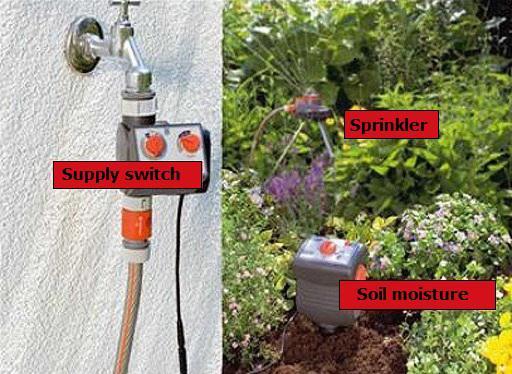
Figure 1. Simple home and garden version
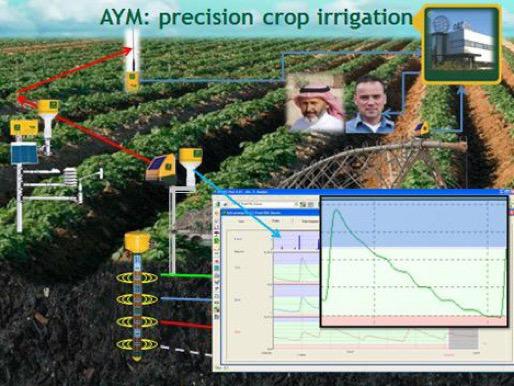
Figure 2. Advanced version (source: DACOM BV)
Functions/ workings
In the simple home version (figure 1) the supply switch receives a signal from the soil moisture sensor when the moisture in the soil drops below a certain pre-determined value. This triggers the supply of water to the sprinkler, which has been set for an adjustable time.
In the advanced version (figure 2) the soil moisture is measured at several depth levels and the information on current weather conditions are sent through to a central computer. Aside from the soil moisture measurements, the control of the irrigation system also allows for measuring and taking other criteria into consideration.
A large number of methods are used in irrigation practice for measuring or estimating the moisture conditions in the soil. The most reliable but also the most labour-intensive method is by means of soil sampling, at various depths with a ground drill. The moisture content is determined by weighing samples before and after drying in an oven. Commercial companies often use tension meters (figure 3) to measure suction tension, from which moisture content is derived.
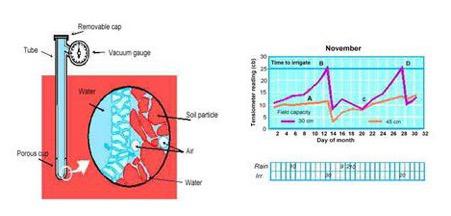
Figure 3. Determining irrigation schedule with tensiometers
Explanation
Two questions have to be asked when irrigating crops: 1. When should irrigation take place? 2. How much water has to be administered? If one does not ask these questions but executes this by ‘gut feel’, there is a risk of irrigating too early or too late, too little or too much. This results in a lower crop yield due to conditions being too wet or too dry in conjunction with suboptimal water productivity. Field experience has shown that too much water is usually given if there is a lack of information about the actual irrigation need. This leads to water waste, subsiding soil or surface water levels and nutrient as well as insecticide run-off into the ground and surface water .
In soil moisture-based irrigation the time and quantity of irrigation is ascertained by means of the actual moisture condition of the soil. The soil moisture is the determining factor in this method. This method of working distinguishes itself from two other methods often applied in irrigation practice:
- Moisture Accounting. The current moisture levels in the soil are not actually measured, but determined from measurement or estimate of at least the precipitation and the present crop evaporation. In actual fact, the moisture stock levels actually depend on many other components as well (Figure 4). In practice, it is impossible to make an exact determination of all these components.
- Observation or measurement of the current moisture condition of the plant. One objection against this method is the fact that once dehydration conditions become visible, the crop is already experiencing a shortage.
The soil moisture content is optimal for crop growth when the crop can access both sufficient water and sufficient oxygen in the root zone. With crop growth on full ground in the open air , the soil moisture content is continually under the influence of precipitation and evaporation. After heavy rainfall, the top layer of the soil is saturated with water . After a few hours, depending on the type of soil, the excess water sinks to the deeper soil layers of the ground water . The soil is then on ‘field capacity’: it contains the maximum quantity of water the ground can hold against the action of gravity. The volume percentage soil moisture at field capacity depends on the soil structure and the soil composition. Evaporation reduces the moisture content in the soil. As the soil dehydrates further , it becomes more difficult for the crop to absorb moisture from the root zone. At the point of wilting, the moisture content of the soil is so low that most crops are unable to absorb water from the soil. The volume percentage soil moisture at wilting point, just like at field capacity, depends on the soil structure and composition (figure 5 and table 1).
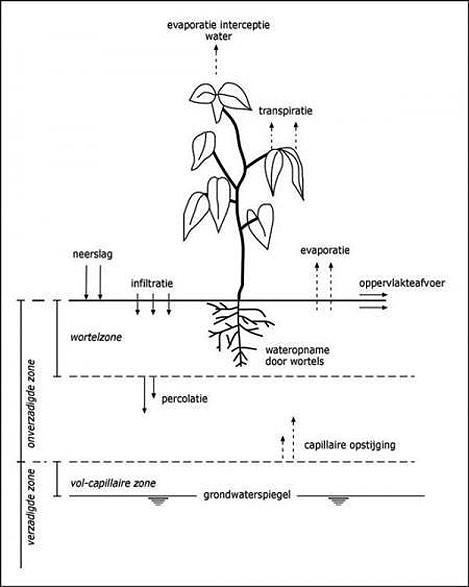
Figure 4. Components of the water balance that are the determining factors for the actual moisture content of the soil.
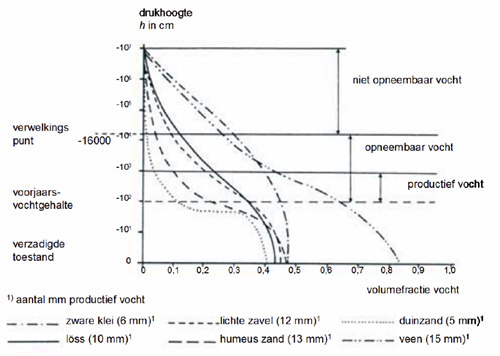
Figure 5. Moisture characteristics for four different types of soil. Source: Cultuurtechnisch vademecum 1971
| Type of soil | Moisture content at field capacity in volume % | Moisture content at wilting point in volume % | Available water quantity in volume % |
| Dune sand | 7 | 5 | 2 |
| Brabant sand soil | 23 | 10 | 13 |
| Young valley soil | 31 | 17 | 14 |
| River clay | 39 | 24 | 15 |
| Sea clay | 33 | 12 | 21 |
Table 1. Moisture holding capacity for different soil types Source: Dr.ir. S.F. Kuipers. 1968. Bodemkunde. [Soil Science] Tjeenk Willink, Zwolle.
Soil moisture-based irrigation means that the actual moisture content in the soil is the determining factor for both the irrigation schedule and the water quantity. The time schedule depends on the chosen strategy. At sufficient water availability, the choice is for maximizing crop yield. Irrigation is scheduled as soon as the soil moisture content has reached a level where the actual evaporation becomes less than the potential evaporation. As much water as required is given to bring the root zone back to field capacity. The irrigation can be postponed or skipped, based on one or more of the following considerations:
- the farmer expects sufficient rain to fall in the short term, which means that he can avoid irrigation costs;
- he expects much rain in the near future. Because of this prospect, he would rather keep a low stock level of moisture in the soil so that a large part of the precipitation can infiltrate the soil. This prevents pool forming, surface run off and possible root damage to the crop;
- the actual moisture shortage occurs in a phase where the crop will incur minimal damage (vegetative growth period) or will even benefit from it (stimulates root growth, matures faster);
- there is insufficient availability of ditch water or the water quality is such that the expected salt damage will be larger than the drought damage.
In an automated system where the soil moisture sensor directly controls the irrigation system, the abovementioned considerations do not play a role: both the time and quantity of irrigation are then only dependent on the previously provided settings of the soil moisture content levels that trigger activation of the irrigation system. In more advanced systems, these considerations can be taken into account. In addition, the system then also provides support for making these decisions. Other water related matters could also play a role, such as preventing or combatting plant disease. The most advanced systems use sensors for soil moisture as well as weather data from a meteostation on the premises, a nearby location or a weather satellite. (See, for instance http://www.hydromedah.nl/downloads/SAT_WATER_HYDROMEDAH_nl.pdf).
Another tool that is used are Crop growth (simulation) models, with which the effects of whether to irrigate or not are estimated. These crop growth models can be adjusted based on the results that were achieved at the same location in previous years.
Costs and benefits
There is insufficient data available for Dutch conditions (as yet) to indicate what the savings could be in terms of water use with soil moisture-based irrigation compared to conventional irrigation. Under controlled conditions, it is easy to show the effect of a soil moisture-based water gift on production (see Figure 6). In the execution of field test in the Netherlands, significant yield differences through irrigation depend on the precipitation pattern. The cost reducing aspect of soil moisturebased irrigation becomes more clearly visible in the decreased use of pesticides and crop protection products. Field tests executed between 1994-2001 for instance, showed a 28% reduction in the spraying against Phytophtora. More examples can be found on www.dacom.nl. In potatoes, there was a significant reduction of up to 50% in the incidence of rot (Delleman, 2010).

- Figure 6. Effect on the growth production in relation to the moisture regime during the growth period. The pots (from left to right) were respectively topped up daily to 100%, 75%, 50% and 25% of the available soil moisture (between pF 2.0 and pF 4.2). Source: Snellen, 1975
Technical specifications
From the above, it appears that soil moisture-based irrigation only becomes viable if irrigation is economically rewarding. Pre-conditions are:
- The evaporative demand and the cumulative precipitation shortage have to be sufficiently large to make irrigation financially cost effective. Expectations are that the precipitation shortages will increase due to climate change, which will result in the conditions being met more frequently in the future.
- Besides the evaporative demand and the precipitation shortage, the moisture storing capacity of the soil also determines the demand for irrigation. This becomes apparent from the fact that the largest irrigated agricultural area is found on the higher sand soils of Limburg and Brabant, where approximately 60% of the farmers have irrigation systems at their disposal.
- In low parts of the Netherlands, the moisture storing capacity is usually higher than it is in the sandy soils. This is also where the cumulative precipitation shortage is supplemented with capillary rise (see Figure 7). When the evaporative demand rises and the groundwater level decreases due to climate change, it will occur more frequently that the moisture retaining capacity plus the capillary rise will be insufficient with regard to meeting the evaporative demand. This will increase the need for irrigation. The composite sensors are able to determine the influence of capillary rise on the current moisture conditions of the soil.
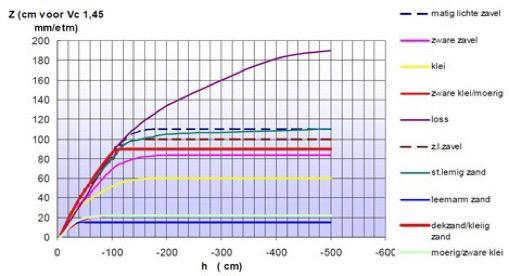
Figure 7. In homogeneous soil, the groundwater level can drop to the stated levels below effective root zone before the soil moisture delivery stagnates
| Claylike sand, surface sand | 90 cm | Heavy slity loam | 84 cm |
| Very loamy cover sand soils | 110 cm | Light clay | 60 cm |
| Löss | 190 cm | Peat/heavy clay | 22 cm |
| Very light sandy loam | 100 cm |
Bron: Huinink, 2011
If irrigation is financially viable, the following considerations apply for the promising application of soil moisture sensors:
- The uniformity of the irrigation has to be sufficiently high. A uniformity of 100 % means that the same amount of water has to be distributed over the complete irrigated surface. Manufacturers of irrigations systems generally back a claim of round about 90% uniformity. In practice, this could prove to be much lower (table 2). Figure 8 provides a test set-up for determining the uniformity at a horticultural company. In this example, fixed sprinklers are used that overlap each other . However , the largest agricultural area in the Netherlands is irrigated with moving sprinkler ‘cannons’, which have a lower degree of uniformity.
- When a soil sensor is used to control irrigation, it is based on the premise that the measured value is representative of a larger area. In the event of low uniformity, this precondition is not met.
| Quality of the irrigation system | Irrigation system rating (ISR) | Distribution uniformity (DU overall) |
| Exceptional | 10 | > 85% |
| Excellent | 9 | 75-84% |
| Very good | 8 | 70-74% |
| Good | 7 | 60-69% |
| Fair | 5 | 50-59% |
| Poor | 3 | 40-49% |
| Fail | < 3 | < 40% |
Table 2. Uniformity of irrigation.(source: http://www.ncwcd.org/ims/ims_info/SummaryEvaluationSprinklerSystems.pdf)
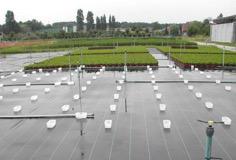
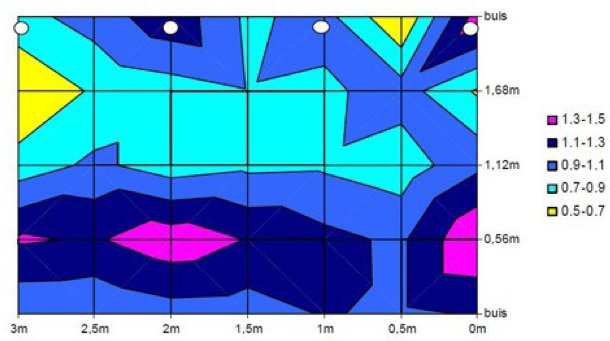
Figure 8: Uniformity of irrigation: test set-up (above) and result (below) (source: http://www.proefstation.be/nederlands/documents/Nieuwsbrief3TDWaterjuni2007.pdf)
Field experience (national and international)
In the WaterSense project more than 100 sensors were placed on a surface of 20,000 hectares with the intention of determining the effect of soil moisture-based irrigation on both production as well as the quality of surface and groundwater . In 2010, the potato yield on the irrigated plots was only 5 to 7% higher than on the non-irrigated plots. According to the researchers, one ‘ cannot meet the costs of the irrigation system with such a low return on investment. On balance, was not successful, the differences are far too small. ’ (Reindsen, 2011). It is evident that under these conditions, it is difficult to make up for the investment in soil moisture sensors (around 2,000 Euro each). There are far more inexpensive sensors on the market that are already being applied on large-scale in agriculture in North America and Australia, and also in southern Europe (see www.Hidrosoph.com). The presence of a large number of commercial companies that offer soil moisture sensors indicates that soil moisture-based irrigation is worthwhile in these areas. One thing that should be taken into consideration however , is the demand and spending power of the recreation industry (especially golf courses). As yet, there is insufficient information available to indicate what the savings are in terms of water use under Dutch conditions.
In final report of WaterSense the abovementioned conclusion remains: the research has shown that the added value of irrigation for agricultural yield was only shown for one of the two potato varieties. The added value was not very large: better use of fertilizer and a (slightly) higher yield. This does not make clear whether irrigation is worthwhile in the current climatological conditions in the Netherlands. The added value of irrigation depends on more factors that were not systematically researched in the project, such as soil, crop/variety, meteorology and production requirements.
Other conclusions from the final report:
- Soil moisture sensors provide a substantial insight into the behaviour of water in the soil. These insights can be used to improve hydrological models. Sensor data show that the hydrological models often overestimate the moisture content of the soil.
- The demonstration model of a decision support system (BOS) built in WaterSense is operational. It has a real-time data feed from soil moisture-based sensors. Farmers are able to use the BOS-forecasts to take measures for optimal water management on the plots. Water managers can use the BOS forecasts for daily water level management and for calculating the effects of measures. BOS can be used for strategic analyses and for answering user questions about groundwater and meteorology. Improvements are required for more complex issues.
- It has become clear that a modular (approach to) BOS will be more suitable for answering many of the daily water issues than an integral BOS. Per user question, a specific application will be compiled that utilizes different sources of information.
- The participating farmers found the BOS information useful for business operations. The information about moisture in the soil helped them to make decisions about irrigation, fertilizing and crop protection. However, for optimal exploitation by farmers, BOS contains too much information. The interpretation of the information can still be improved.
- A BOS for water quality to help the farmer in his use of crop protection products and fertilization is not on the horizon. The reason: it is still very difficult to predict the behaviour of crop protection products and nitrate with a model and, there are no suitable sensors that can measure the water quality in the topsoil layer. DACOM has started with prototype development of a nitrogen sensor and expectations are that it will be brought to market in 2014.
- WaterSense met the characteristics of a ‘golden triangle’ for innovation: business, government and knowledge institutes working together on innovation. WaterSense teaches that it is important to hold onto a common goal, taking into account the commercial interests, public considerations and the development of new knowledge. Participating parties will apply the knowledge gained in future cooperation and in their own circle.
Knowledge gaps
For Dutch conditions, it can be made plausible that moisture-based irrigation leads to a reduction in crop protection products. There is insufficient data available to quantify the effect on water use. http://www.projectwatersense.nl/_pdf/publiek/Eindrapport%20WaterSense.pdf
There is a striking discrepancy between the trouble taken by the researchers and companies to accurately determine the irrigation requirements on the one hand, while on the other hand, their (in)accuracy at water supply on plot level. Also see the text on uniformity under pre-conditions.
The use of soil sensors to ascertain the irrigation requirements – as well as the application of mathematical models – is based on the assumptions that soils are homogeneous and that crop growth is determined by physical and chemical soil conditions. In actual fact, the soil is often highly heterogeneous and biological factors are co-determining in crop growth.
Knowledge questions from the final report of WaterSense:
- In what way does the added value of irrigation depend on factors such as soil, crop/variety, meteorology and production requirements?
- It would be a good thing to investigate whether it is possible to build a modular BOS.
- Is it possible to forecast flooding in the growth season and take timely action to prevent damage?
- What is the added value of intelligent water level management for agricultural yield?
- Is it more sensible to irrigate from groundwater or from surface water?
- Which fresh water strategies can best be chosen?
- What is the (economic) added value of irrigation and what are the factors that play a role in this?
- What are the effects of irrigation on the rapid die off and recovery ability of a crop after drought?
- What is the effect of ‘moment of harvest’ on yield with irrigation / non-irrigation?
Overview of currently active projects and research
| Research project | Research location | Links/documents |
| WaterSense | Peat colonies Drenthe | www.projectwatersense.nl |
| High Tech Irrigation Made-tomeasure | Companies in NB | |
| Farm Level Optimal Water management: Assistant for Irrigation under Deficit (FlowAid) | Italy, Spain, Turkey, Jordan, Lebanon |

 English resume
English resume